Sorption of Pb(II) from Aqueous Solutions by Acid-Modified Clinoptilolite-Rich Tuffs with Different Si/Al Ratios
Abstract
1. Introduction
2. Materials and Methods
2.1. Clinoptilolite-Rich Tuff and Conditioning
2.2. Samples Characterization
2.3. Sorption Experiments
2.3.1. Kinetic
2.3.2. Isotherm
2.3.3. Influence of Adsorbent Dosage and Effect of pH
3. Results and Discussion
3.1. Characterization
3.2. Point of Zero Charge pH (pHPZC)
3.3. Kinetic
3.4. Isotherm
3.5. Partition Coefficients
3.6. Influence of Adsorbent Dosage
3.7. Effect of the Solution pH
4. Conclusions
Author Contributions
Funding
Conflicts of Interest
References
- Krajisnik, D.; Milojević-Rakić, M.; Malenović, A.; Daković, A.; Ibric, S.; Savić, S.; Dondur, V.; Matijašević, S.; Radulović, A.; Daniels, R.; et al. Cationic surfactants-modified natural zeolites: Improvement of the excipients functionality. Drug Dev. Ind. Pharm. 2010, 36, 1215–1224. [Google Scholar] [CrossRef] [PubMed]
- Mansoor, E.; Van Der Mynsbrugge, J.; Head-Gordon, M.; Bell, A.T. Impact of long-range electrostatic and dispersive interactions on theoretical predictions of adsorption and catalysis in zeolites. Catal. Today 2018, 312, 51–65. [Google Scholar] [CrossRef]
- Wang, S.; Peng, Y. Natural zeolites as effective adsorbents in water and wastewater treatment. Chem. Eng. J. 2010, 156, 11–24. [Google Scholar] [CrossRef]
- Louis, B.; Walspurger, S.; Sommer, J. Quantitative Determination of Brönsted Acid Sites on Zeolites: A New Approach Towards the Chemical Composition of Zeolites. Catal. Lett. 2004, 93, 81–84. [Google Scholar] [CrossRef]
- Zhong, J.; Han, J.; Wei, Y.; Tian, P.; Guo, X.; Song, C.; Liu, Z. Recent advances of the nano-hierarchical SAPO-34 in the methanol-to-Olefin (MTO) reaction and other applications. Catal. Sci. Technol. 2017, 7, 4905–4923. [Google Scholar] [CrossRef]
- Sprynskyy, M.; Buszewski, B.; Terzyk, A.P.; Namie, J. Study of the selection mechanism of heavy metal (Pb2+, Cu2+, Ni2+, and Cd2+) adsorption on clinoptilolite. J. Colloid Interface Sci. 2006, 304, 21–28. [Google Scholar] [CrossRef]
- Jiang, N.; Shang, R.; Heijman, S.G.; Rietveld, L.C. High-silica zeolites for adsorption of organic micro-pollutants in water treatment: A review. Water Res. 2018, 144, 145–161. [Google Scholar] [CrossRef] [PubMed]
- Garrido-Ramírez, E.; Theng, B.; Mora, M. Clays and oxide minerals as catalysts and nanocatalysts in Fenton-like reactions—A review. Appl. Clay Sci. 2010, 47, 182–192. [Google Scholar] [CrossRef]
- Reháková, M.; Čuvanová, S.; Dzivák, M.; Rimár, J.; Gaval’Ová, Z. Agricultural and agrochemical uses of natural zeolite of the clinoptilolite type. Curr. Opin. Solid State Mater. Sci. 2004, 8, 397–404. [Google Scholar] [CrossRef]
- Erdem, E.; Karapinar, N.; Donat, R. The removal of heavy metal cations by natural zeolites. J. Colloid Interface Sci. 2004, 280, 309–314. [Google Scholar] [CrossRef]
- Vocciante, M.; D’Auris, A.D.F.; Finocchi, A.; Tagliabue, M.; Bellettato, M.; Ferrucci, A.; Reverberi, A.P.; Ferro, S.; D’Auris, A.D.F. Adsorption of ammonium on clinoptilolite in presence of competing cations: Investigation on groundwater remediation. J. Clean. Prod. 2018, 198, 480–487. [Google Scholar] [CrossRef]
- Abatal, M.; Olguin, M.T.; Abdellaoui, Y.; Bouari, A.E. Sorption of Cd(II), Ni(II) and Zn(II) on natural, sodium-, and acid-Modified clinoptilolite-Rich tuff. Env. Prot. Eng. 2018, 44, 41–59. [Google Scholar]
- Abatal, M.; Olguin, M.T. Evaluating of effectiveness of a natural and modified surface mexican clinoptilolite-rich tuff in removing phenol and p-Nitrophenol from aqueous solutions. Environ. Prot. Eng. 2012, 38, 53–65. [Google Scholar]
- Abatal, M.; Olguin, M.T. Comparison of lead removal from aqueous solution between natural-, sodium-, and acid-modified clinoptilolite-rich tuffs. Desalin. Water Treat. 2017, 72, 318–327. [Google Scholar] [CrossRef]
- Doula, M.; Ioannou, A. The effect of electrolyte anion on Cu adsorption–desorption by clinoptilolite. Microporous Mesoporous Mater. 2003, 58, 115–130. [Google Scholar] [CrossRef]
- Ates, A.; Akgül, G. Modification of natural zeolite with NaOH for removal of manganese in drinking water. Powder Technol. 2016, 287, 285–291. [Google Scholar] [CrossRef]
- Dakovi, A.; Gatta, G.D.; Rotiroti, N. Applied Surface Science Characterization of lead sorption by the natural and Fe (III)-modified zeolite. Appl. Surf. Sci. 2013, 283, 764–774. [Google Scholar]
- Garcia-Basabe, Y.; Rodriguez-Iznaga, I.; De Menorval, L.-C.; Llewellyn, P.; Maurin, G.; Lewis, D.W.; Binions, R.; Autie, M.; Ruiz-Salvador, A.R. Step-wise dealumination of natural clinoptilolite: Structural and physicochemical characterization. Microporous Mesoporous Mater. 2010, 135, 187–196. [Google Scholar] [CrossRef]
- Matsui, M.; Kiyozumi, Y.; Mizushina, Y.; Sakaguchi, K.; Mizukami, F. Adsorption and desorption behavior of basic proteins on zeolites. Sep. Purif. Technol. 2015, 149, 103–109. [Google Scholar] [CrossRef]
- Tsai, W.-T.; Hsu, H.-C.; Su, T.-Y.; Lin, K.-Y.; Lin, C.-M. Adsorption characteristics of bisphenol-A in aqueous solutions onto hydrophobic zeolite. J. Colloid Interface Sci. 2006, 299, 513–519. [Google Scholar] [CrossRef]
- Zhao, X.S.; Ma, Q.; Lu, G.Q. (Max) VOC Removal: Comparison of MCM-41 with Hydrophobic Zeolites and Activated Carbon. Energy Fuels 1998, 12, 1051–1054. [Google Scholar] [CrossRef]
- Abelló, S.; Bonilla, A.; Pérez-Ramírez, J. Mesoporous ZSM-5 zeolite catalysts prepared by desilication with organic hydroxides and comparison with NaOH leaching. Appl. Catal. A Gen. 2009, 364, 191–198. [Google Scholar] [CrossRef]
- Ateş, A. Effect of alkali-treatment on the characteristics of natural zeolites with different compositions. J. Colloid Interface Sci. 2018, 523, 266–281. [Google Scholar] [CrossRef] [PubMed]
- Malekian, R.; Abedi-Koupai, J.; Eslamian, S.S.; Mousavi, S.F.; Abbaspour, K.C.; Afyuni, M. Ion-exchange process for ammonium removal and release using natural Iranian zeolite. Appl. Clay Sci. 2011, 51, 323–329. [Google Scholar] [CrossRef]
- Gili, M.B.Z.; Conato, M.T. Adsorption uptake of mordenite-type zeolites with varying Si/Al ratio on Zn2+ ions in aqueous solution. Mater. Res. Express 2019, 6, 045508. [Google Scholar] [CrossRef]
- Ong, L.H.; Dömök, M.; Olindo, R.; van Veen, A.C.; Lercher, J.A. Microporous and Mesoporous Materials Dealumination of HZSM-5 via steam-Treatment. Microporous Mesoporous Mater. 2012, 164, 9–20. [Google Scholar] [CrossRef]
- Müller, J.M.; Mesquita, G.C.; Franco, S.M.; Borges, L.D.; de Macedo, J.L.; Dias, J.A.; Dias, S.C.L. Microporous and Mesoporous Materials Solid-State dealumination of zeolites for use as catalysts in alcohol dehydration. Microporous Mesoporous Mater. 2015, 204, 50–57. [Google Scholar] [CrossRef]
- Kuwahara, Y.; Aoyama, J.; Miyakubo, K.; Eguchi, T.; Kamegawa, T.; Mori, K.; Yamashita, H. TiO2 photocatalyst for degradation of organic compounds in water and air supported on highly hydrophobic FAU zeolite: Structural, sorptive, and photocatalytic studies. J. Catal. 2012, 285, 223–234. [Google Scholar] [CrossRef]
- Wang, C.; Cao, L.; Huang, J. Influences of acid and heat treatments on the structure and water vapor adsorption property of natural zeolite. Surf. Interface Anal. 2017, 49, 1249–1255. [Google Scholar] [CrossRef]
- Matias, P.; Couto, C.S.; Graça, I.; Lopes, J.M.; Carvalho, A.P.; Ribeiro, F.R.; Guisnet, M. Applied Catalysis A: General Desilication of a TON zeolite with NaOH: Influence on porosity, acidity and catalytic properties. Appl. Catal. A Gen. 2011, 399, 100–109. [Google Scholar] [CrossRef]
- Kussainova, M.Z.; Chernyakov, R.M.; Jussipbekov, Z.U.; Pas, S. Structural investigation of raw clinoptilolite over the Pb2+ adsorption process from phosphoric acid. J. Mol. Struct. 2019, 1184, 49–58. [Google Scholar] [CrossRef]
- Ma, W.; Ya, F.-Q.; Han, M.; Wang, R. Characteristics of equilibrium, kinetics studies for adsorption of fluoride on magnetic-chitosan particle. J. Hazard. Mater. 2007, 143, 296–302. [Google Scholar] [CrossRef] [PubMed]
- Ho, Y.-S.; Chiu, W.-T.; Wang, C.-C. Regression analysis for the sorption isotherms of basic dyes on sugarcane dust. Bioresour. Technol. 2005, 96, 1285–1291. [Google Scholar] [CrossRef] [PubMed]
- Treacy, M.M.J.; Higgins, J.B. Collection of Simulated Xrd Powder Patterns For Zeolites, 4th ed.; Elsevier: Amsterdam, The Netherlands, 2001. [Google Scholar]
- Cobzaru, C.; Oprea, S.; Dumitriu, E.; Hulea, V. Gas phase aldol condensation of lower aldehydes over clinoptilolite rich natural zeolites. Appl. Catal. A Gen. 2008, 351, 253–258. [Google Scholar] [CrossRef]
- Wang, C.; Leng, S.; Guo, H.; Cao, L.; Huang, J. Applied Surface Science Acid and alkali treatments for regulation of hydrophilicity/hydrophobicity of natural zeolite. Appl. Surf. Sci. 2019, 478, 319–326. [Google Scholar] [CrossRef]
- Peng, S.; Hao, K.; Han, F.; Tang, Z.; Niu, B.; Zhang, X.; Wang, Z.; Hong, S. Enhanced removal of bisphenol-AF onto chitosan-modified zeolite by sodium cholate in aqueous solutions. Carbohydr. Polym. 2015, 130, 364–371. [Google Scholar] [CrossRef] [PubMed]
- Elaiopoulos, K.; Perraki, T.; Grigoropoulou, E. Microporous and Mesoporous Materials Monitoring the effect of hydrothermal treatments on the structure of a natural zeolite through a combined XRD, FTIR, XRF, SEM and N2-Porosimetry analysis. Microporous Mesoporous Mater. 2010, 134, 29–43. [Google Scholar] [CrossRef]
- Rožić, M.; Cerjan-Stefanović, Š.; Kurajica, S.; Maěefat, M.R.; Margeta, K.; Farkaš, A. Decationization and dealumination of clinoptilolite tuff and ammonium exchange on acid-Modified tuff. J. Colloid Interface Sci. 2005, 284, 48–56. [Google Scholar] [CrossRef]
- Pechar, F.; Rykl, D. Infrared spectra of natural zeolites of the stilbite group. Chem. Pap. 1981, 35, 189–202. [Google Scholar]
- Stojanović, M.; Matijašević, S.; Zildžović, S.; Stojanović, J.; Đošić, M.; Nikolić, J.; Stojanović, M.; Labus, N. Removal of uranium (VI) from aqueous solution by acid modified zeolites. Zastita Materijala 2016, 57, 551–558. [Google Scholar]
- Lee, C.-G.; Jeon, J.-W.; Hwang, M.-J.; Ahn, K.-H.; Park, C.; Choi, J.-W.; Lee, S.-H. Lead and copper removal from aqueous solutions using carbon foam derived from phenol resin. Chemosphere 2015, 130, 59–65. [Google Scholar] [CrossRef] [PubMed]
- Wongrod, S.; Simon, S.; Guibaud, G.; Lens, P.N.; Pechaud, Y.; Huguenot, D.; Van Hullebusch, E.D. Lead sorption by biochar produced from digestates: Consequences of chemical modification and washing. J. Environ. Manag. 2018, 219, 277–284. [Google Scholar] [CrossRef] [PubMed]
- Kończyk, J.; Żarska, S.; Ciesielski, W. Adsorptive removal of Pb(II) ions from aqueous solutions by multi-walled carbon nanotubes functionalised by selenophosphoryl groups: Kinetic, mechanism, and thermodynamic studies. Colloids Surf. A: Physicochem. Eng. Asp. 2019, 575, 271–282. [Google Scholar] [CrossRef]
- Nejadshafiee, V.; Islami, M.R. Adsorption capacity of heavy metal ions using sultone-modified magnetic activated carbon as a bio-adsorbent. Mater. Sci. Eng. C 2019, 101, 42–52. [Google Scholar] [CrossRef] [PubMed]
- Koksharov, S.A.; Aleeva, S.V.; Lepilova, O.V. Description of adsorption interactions of lead ions with functional groups of pectin-containing substances. J. Mol. Liq. 2019, 283, 606–616. [Google Scholar] [CrossRef]
- Wang, X.; Plackowski, C.A.; Nguyen, A.V. X-ray photoelectron spectroscopic investigation into the surface effects of sulphuric acid treated natural zeolite. Powder Technol. 2016, 295, 27–34. [Google Scholar] [CrossRef]
- Yang, X.; Yang, S.; Yang, S.; Hu, J.; Tan, X.; Wang, X. Effect of pH, ionic strength and temperature on sorption of Pb(II) on NKF-6 zeolite studied by batch technique. Chem. Eng. J. 2011, 168, 86–93. [Google Scholar] [CrossRef]
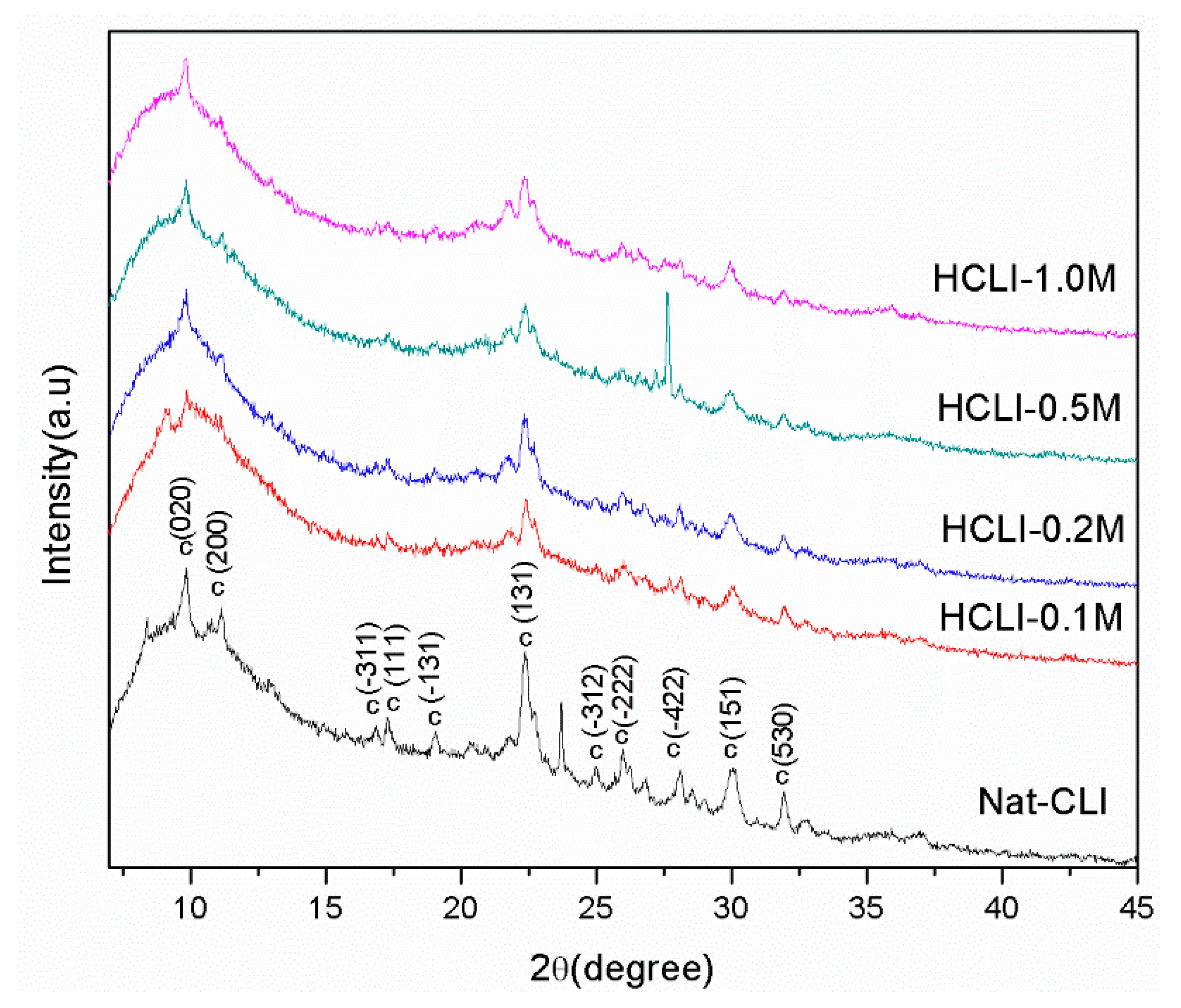
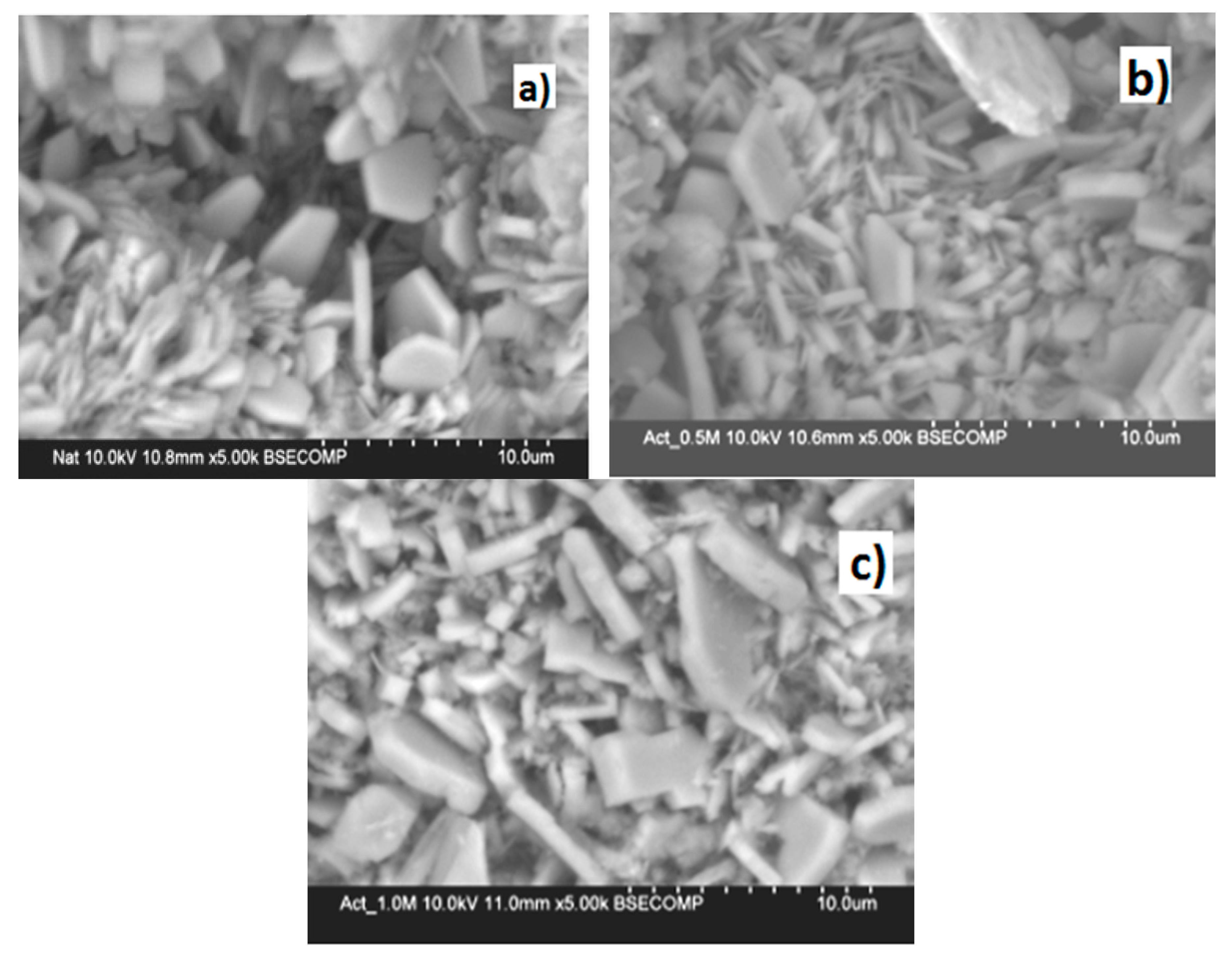
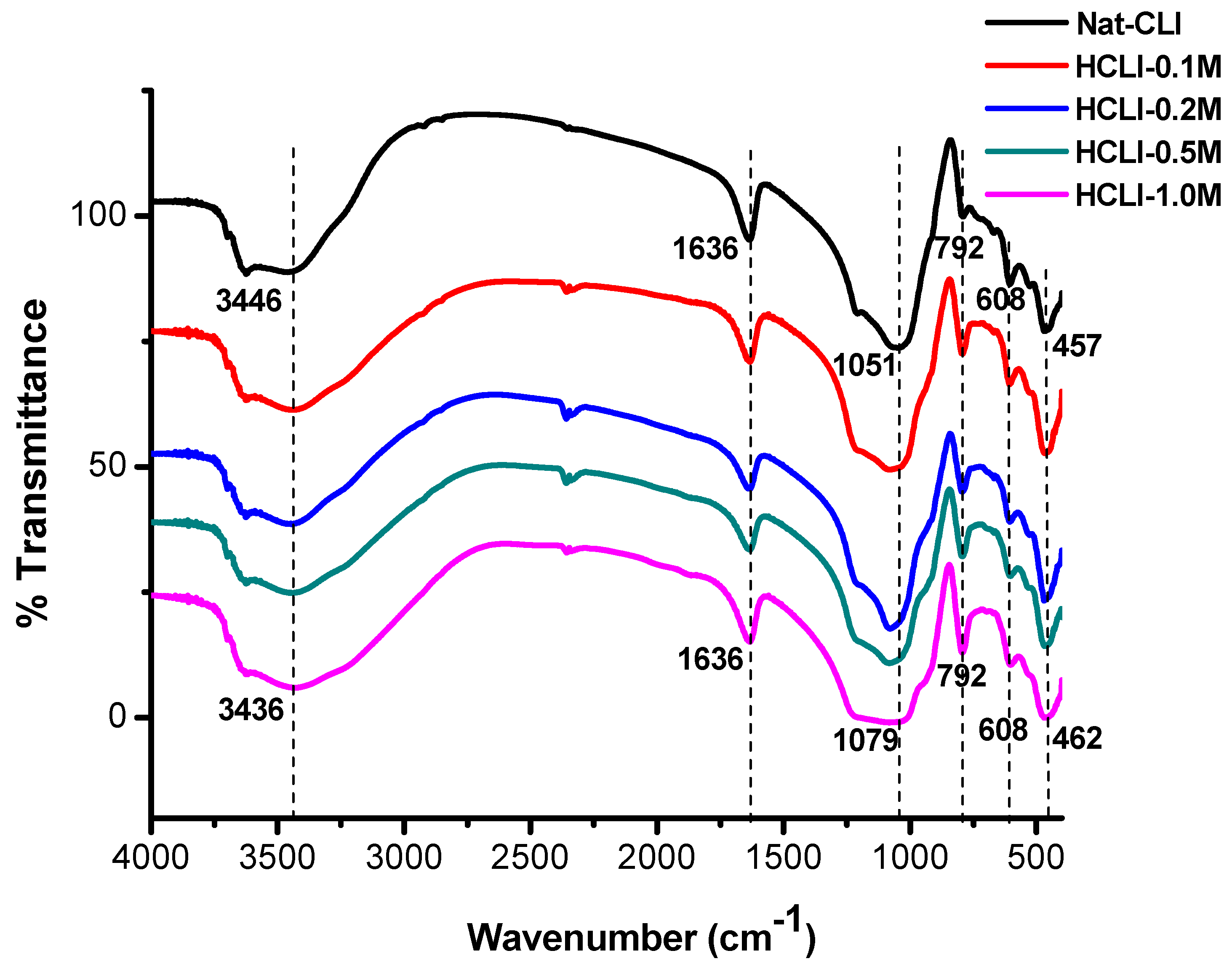
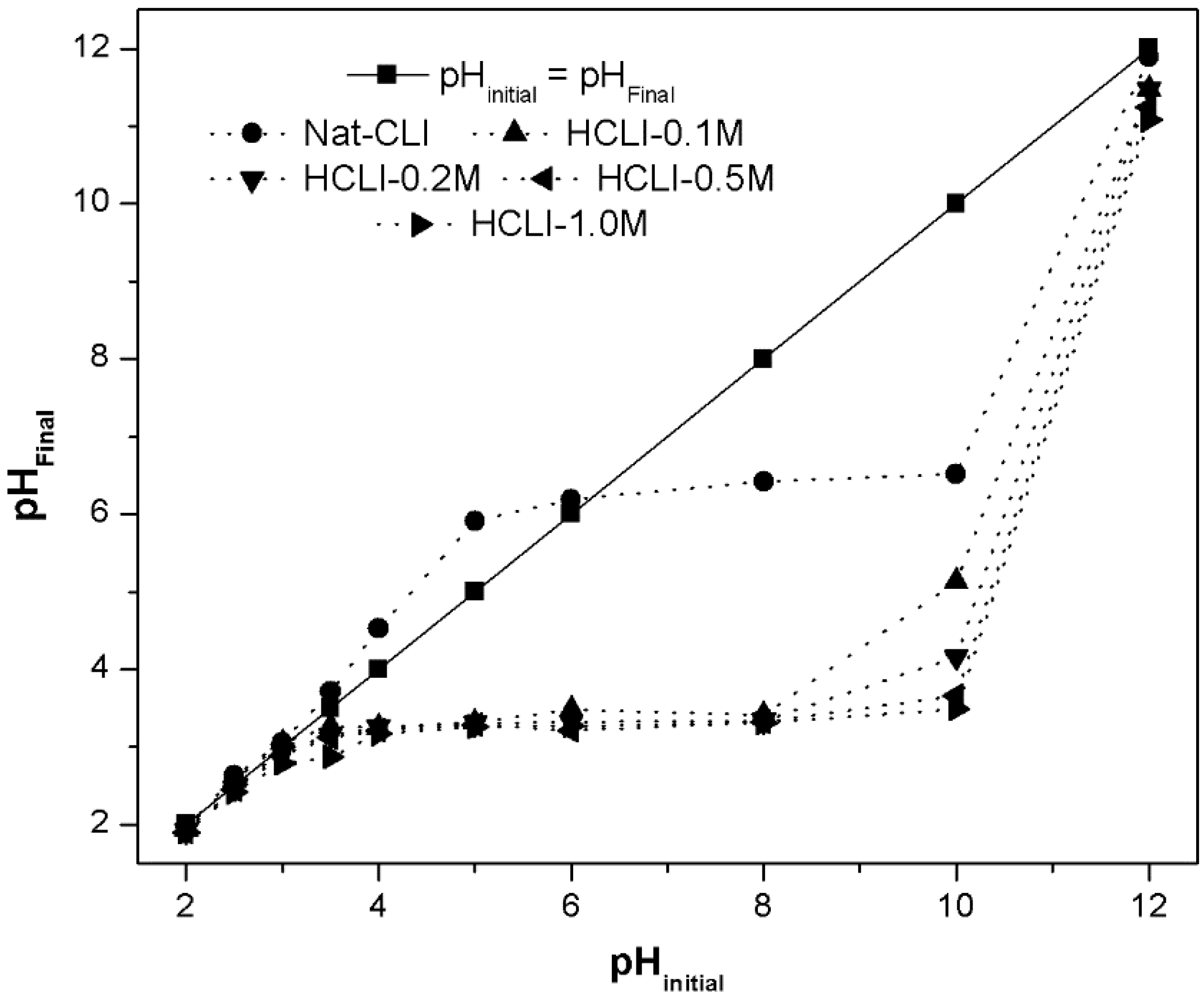
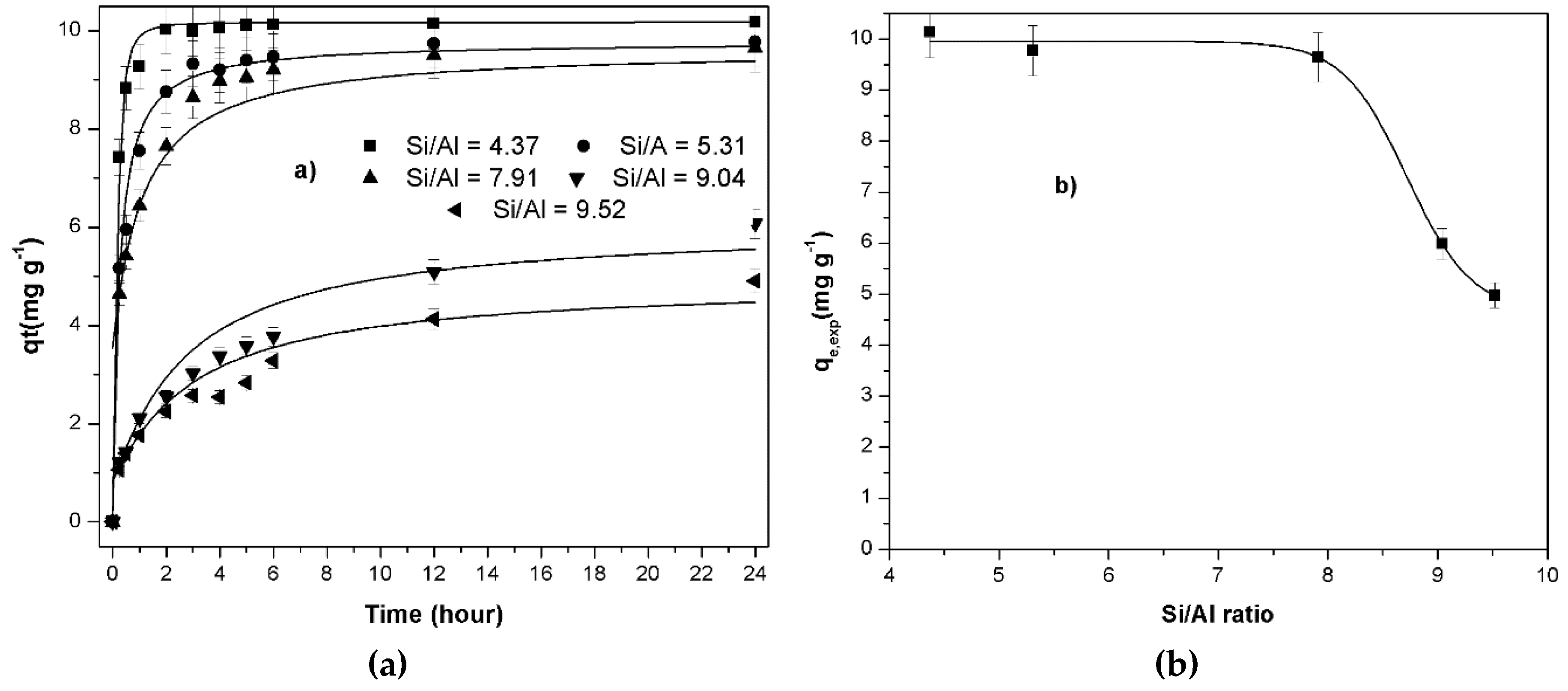
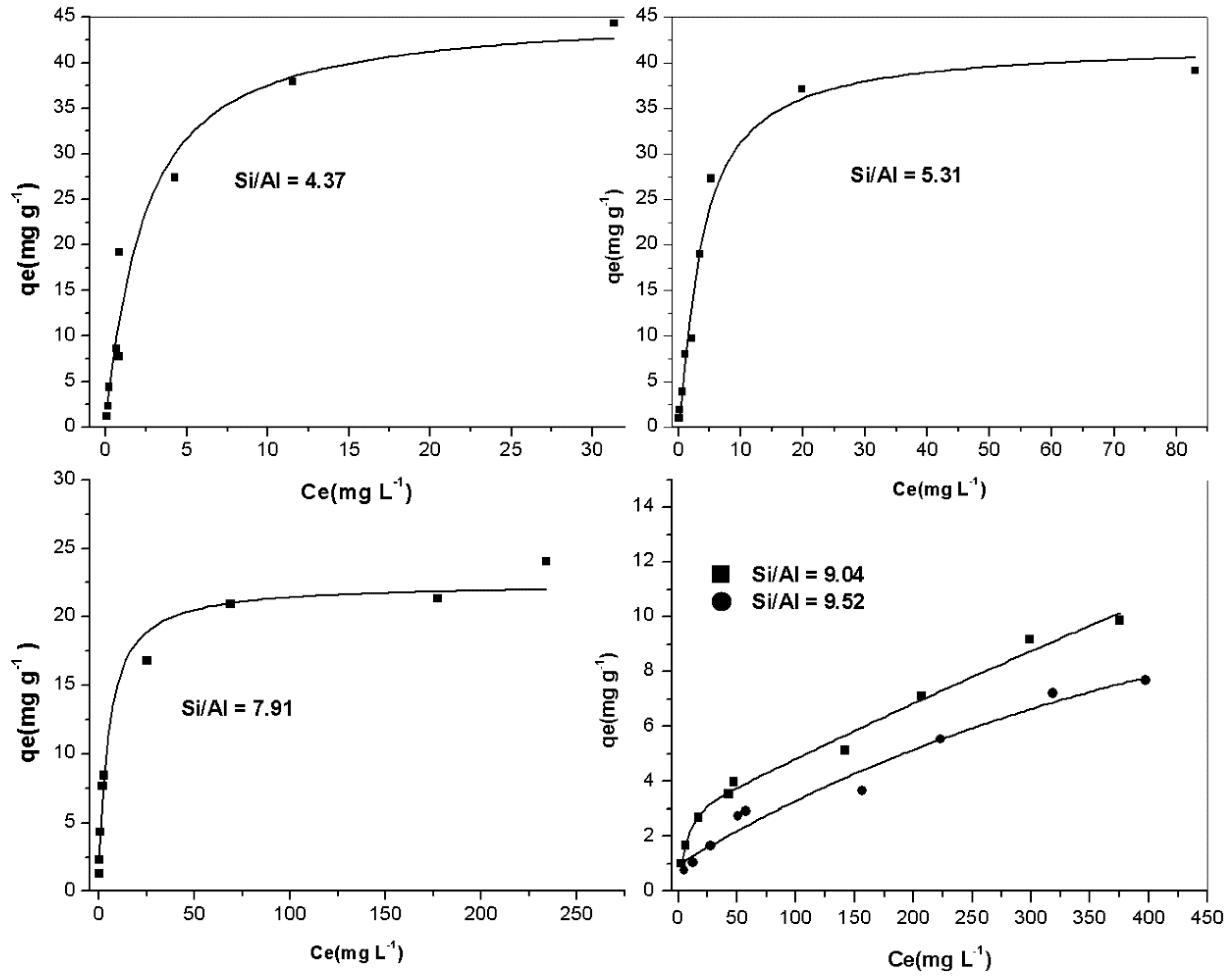

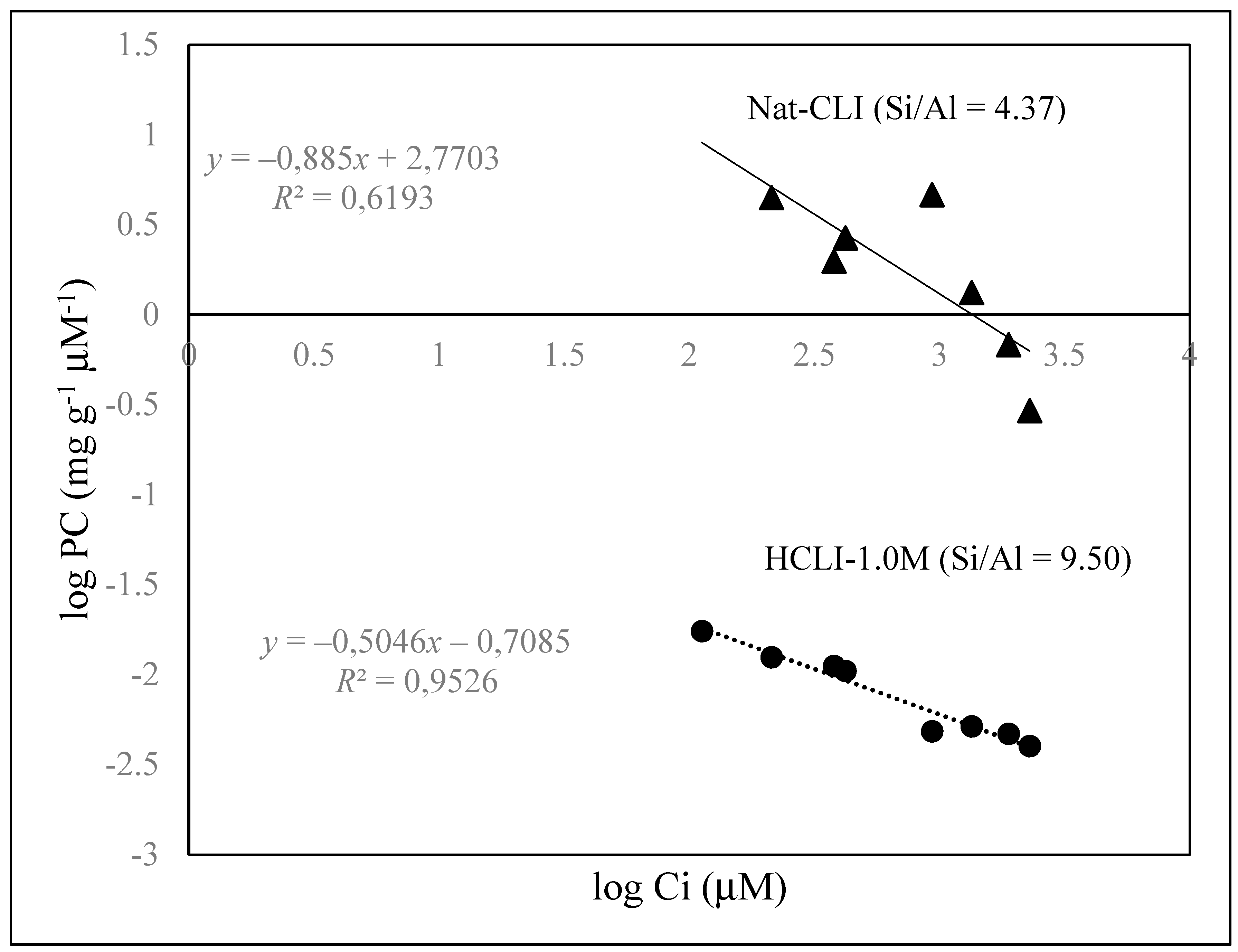
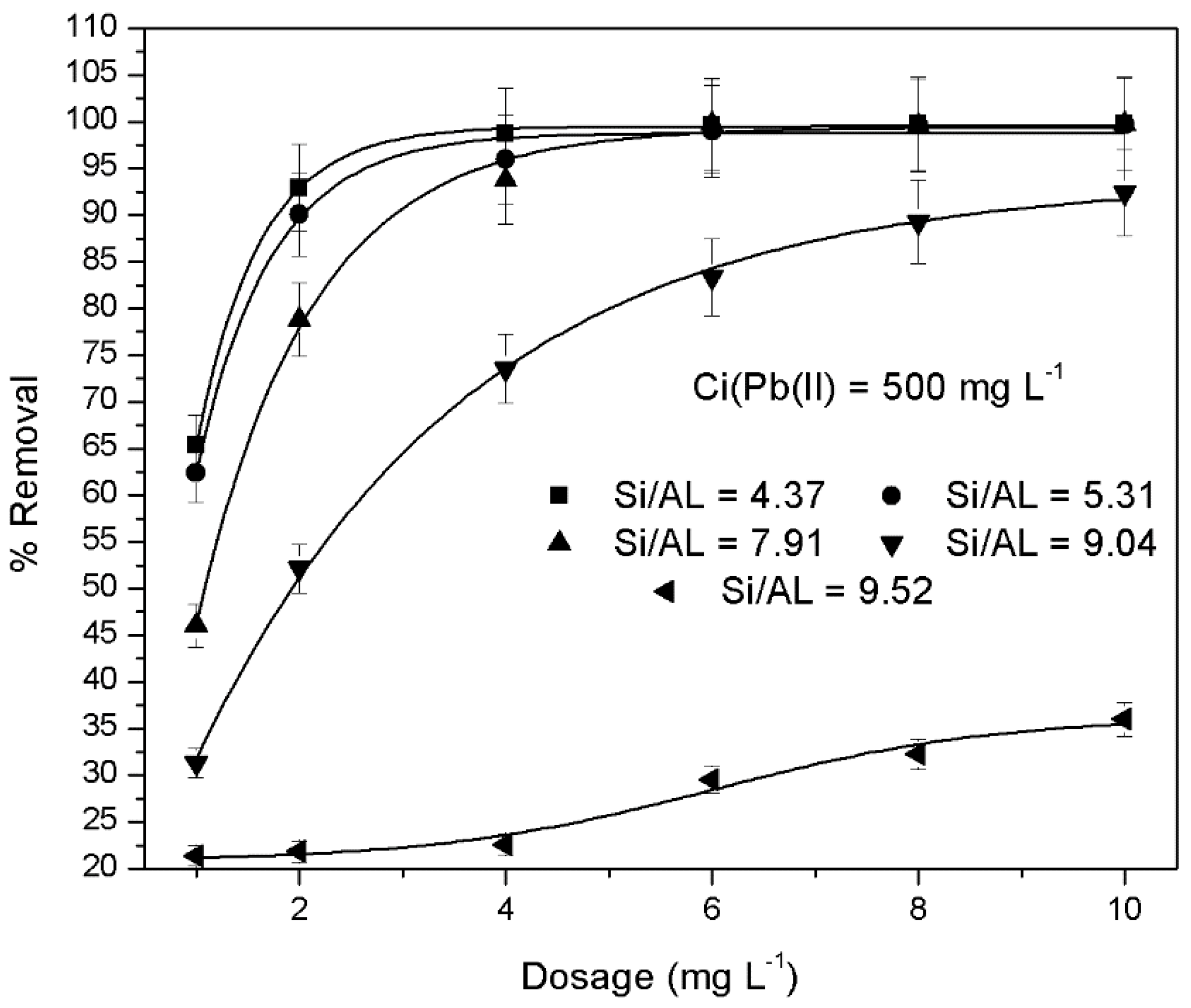
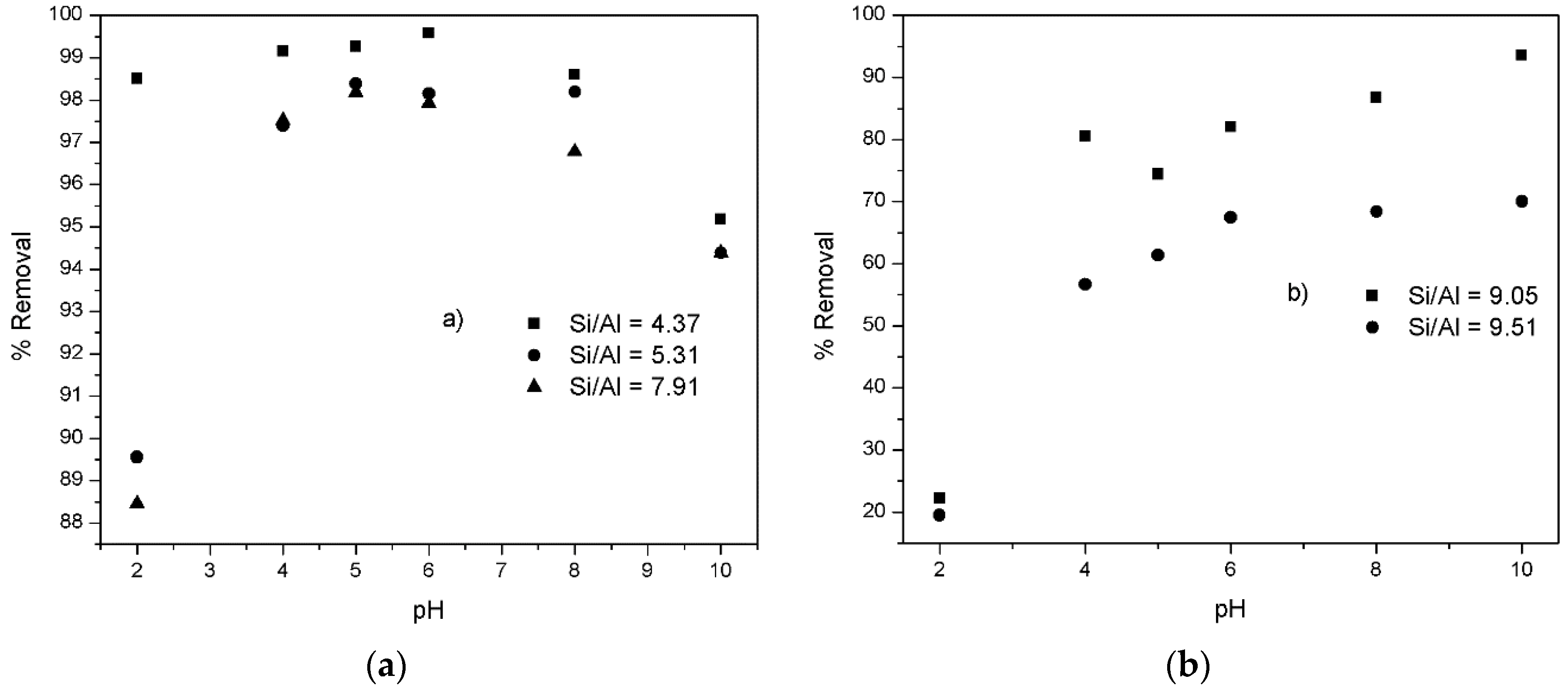
| Sample | Si/Al | Weight, % | |||||||
|---|---|---|---|---|---|---|---|---|---|
| O | Na | K | Ca | Mg | Si | Al | Fe | ||
| Nat-CLI | 4.37 | 64.37 | 0.56 | 1.17 | 1.65 | 0.21 | 25.77 | 5.90 | 0.37 |
| HCLI-0.1 M | 5.31 | 66.67 | 0.00 | 0.95 | 0.92 | 0.17 | 26.08 | 4.91 | 0.29 |
| HCLI-0.2 M | 7.91 | 66.6 | 0.00 | 0.59 | 0.29 | 0.00 | 28.70 | 3.63 | 0.19 |
| HCLI-0.5 M | 9.04 | 64.06 | 0.00 | 0.49 | 0.52 | 0.00 | 31.37 | 3.47 | 0.09 |
| HCLI-1.0 M | 9.52 | 68.99 | 0.00 | 0.46 | 0.22 | 0.00 | 27.32 | 2.87 | 0.07 |
| Sample | Si/Al | Kinetic Models | ||||||
|---|---|---|---|---|---|---|---|---|
| Pseudo-Second Order | Pseudo-First Order | |||||||
| qe(exp) | qe(cal) | k2 × 102 | R2 | qe(cal) | k1 × 102 | R2 | ||
| Nat-CLI | 4.37 | 10.14 | 10.21 | 2.39 | 1.0 | 0.53 | 0.27 | 0.60 |
| HCLI-0.1 M | 5.31 | 9.77 | 9.90 | 0.63 | 1.0 | 1.76 | 0.24 | 0.69 |
| HCLI-0.2 M | 7.91 | 9.64 | 9.82 | 0.40 | 0.99 | 2.53 | 0.23 | 0.76 |
| HCLI-0.5 M | 9.04 | 5.98 | 6.37 | 0.08 | 0.96 | 5.00 | 0.17 | 0.99 |
| HCLI-1.0 M | 9.52 | 4.98 | 5.25 | 0.11 | 0.97 | 3.97 | 0.21 | 0.99 |
| Sample | Si/Al | Langmuir Isotherm | ||
| qm (mg/g) | KL (dm3/mg) | R2 | ||
| Nat-CLI | 4.37 | 48.07 | 0.3598 | 0.9939 |
| HCLI-0.1 M | 5.31 | 41.49 | 0.2175 | 0.9970 |
| HCLI-0.2 M | 7.91 | 23.47 | 0.1969 | 0.9948 |
| 9.04 | 10.67 | 0.0146 | 0.9163 | |
| 9.50 | 9.30 | 0.0081 | 0.8816 | |
| Freundlich Isotherm | ||||
| Sample | Si/Al | KF (mg g−1) (L mg−1)1/n | n | R2 |
| HCLI-0.5 M | 9.04 | 0.701 | 2.279 | 0.99 |
| HCLI-1.0 M | 9.52 | 0.295 | 1.849 | 0.98 |
| Material | qm (mg g−1) | Reference |
|---|---|---|
| Carbon foam | 491.36 | [42] |
| Biochar | 151.5 | [43] |
| Multi-walled carbon nanotubes functionalized by selenophosphoryl groups | 149.25 | [44] |
| Sultone-modified magnetic activated carbon | 147.5 | [45] |
| Pectin-containing substances | 25.15 | [46] |
| Clinoptilolite-rich tuff (Nat-CLI) | 48.07 | Present work |
| Clinoptilolite-rich tuff acidified using a solution 1.0 M of H2SO4 | 9.30 | Present work |
© 2019 by the authors. Licensee MDPI, Basel, Switzerland. This article is an open access article distributed under the terms and conditions of the Creative Commons Attribution (CC BY) license (http://creativecommons.org/licenses/by/4.0/).
Share and Cite
Abatal, M.; Córdova Quiroz, A.V.; Olguín, M.T.; Vázquez-Olmos, A.R.; Vargas, J.; Anguebes-Franseschi, F.; Giácoman-Vallejos, G. Sorption of Pb(II) from Aqueous Solutions by Acid-Modified Clinoptilolite-Rich Tuffs with Different Si/Al Ratios. Appl. Sci. 2019, 9, 2415. https://doi.org/10.3390/app9122415
Abatal M, Córdova Quiroz AV, Olguín MT, Vázquez-Olmos AR, Vargas J, Anguebes-Franseschi F, Giácoman-Vallejos G. Sorption of Pb(II) from Aqueous Solutions by Acid-Modified Clinoptilolite-Rich Tuffs with Different Si/Al Ratios. Applied Sciences. 2019; 9(12):2415. https://doi.org/10.3390/app9122415
Chicago/Turabian StyleAbatal, Mohamed, Atl V. Córdova Quiroz, María T. Olguín, América R. Vázquez-Olmos, Joel Vargas, Francisco Anguebes-Franseschi, and German Giácoman-Vallejos. 2019. "Sorption of Pb(II) from Aqueous Solutions by Acid-Modified Clinoptilolite-Rich Tuffs with Different Si/Al Ratios" Applied Sciences 9, no. 12: 2415. https://doi.org/10.3390/app9122415
APA StyleAbatal, M., Córdova Quiroz, A. V., Olguín, M. T., Vázquez-Olmos, A. R., Vargas, J., Anguebes-Franseschi, F., & Giácoman-Vallejos, G. (2019). Sorption of Pb(II) from Aqueous Solutions by Acid-Modified Clinoptilolite-Rich Tuffs with Different Si/Al Ratios. Applied Sciences, 9(12), 2415. https://doi.org/10.3390/app9122415






